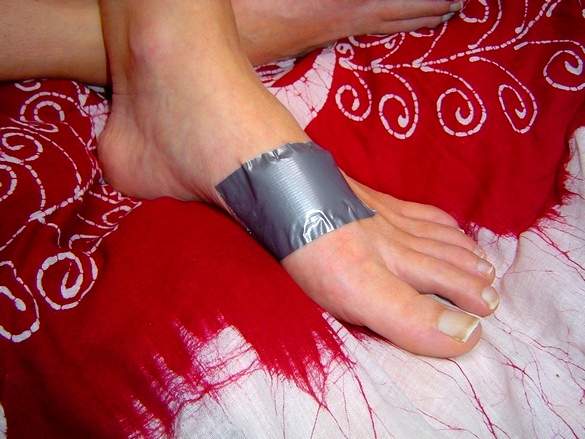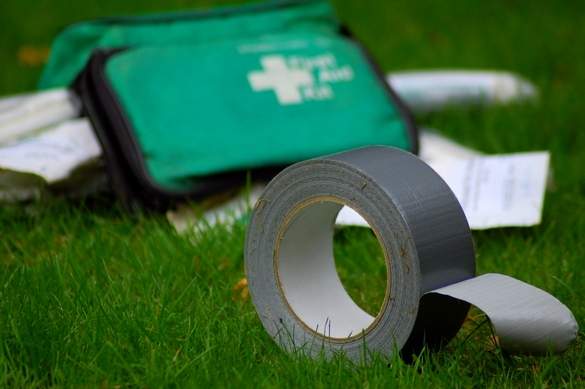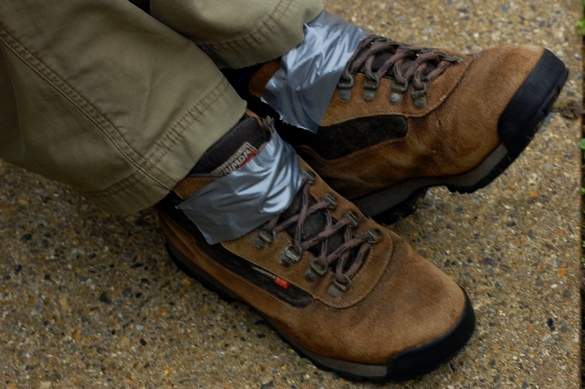The very nature of independent travel sees us seeking out the far-flung, probing and plunging into exotic corners and reveling in all that is alien and strange to our senses. That is until we break, wear out or run out of something we consider vital; suddenly it is brought sharply home to us that there is no replacing that particular item any-time soon. At the very least this is going to be annoying, but at worst it can have implications for our health and well-being and put the rest of the trip into jeopardy.
Enter the humble duct tape, the backpacker’s savior. Now, if you find it difficult to raise your enthusiasm thermometer beyond lukewarm on the subject of duct tape, you may be forgiven for laughing at this point. My reaction was exactly the same a few years ago but the truth is that once you have traveled with a reel of duct tape, you will never again leave home without it. Duct tape is by far and away my most precious piece of kit and is always the first thing that goes into my rucksack when the wanderlust calls.
[social]
Each trip I take adds at least one more entry to the long scroll entitled ‘duct tape to the rescue’. Here are the uses that seem to crop up the most.
#1. Treating tropical sores
I discovered the use of duct tape for tropical sores quite by accident and in sheer desperation when I had run out of dressings in the middle of nowhere. The tiniest of cuts, grazes or insect bites can turn nasty at a galloping pace in the tropics. If micro-organisms or bacteria enter into a wound the results can range from a mild infection to soft tissue necrosis and can result in amputation.
I had been totally ignorant of the danger from tropical sores until a slight scratch progressed into an infection that manifested as large crater like holes in my foot in just a matter of weeks. I had exacerbated the problem by continuing to surf in waters that perhaps weren’t the cleanest, and now I was beginning to panic.
I had run out of all types of dressing and in desperation turned to the one thing I did have – duct tape. What I didn’t know then, but have since found out, is that the duct tape worked ten times better than any other dressing because it created an airtight containment for my infection. Bacteria needs oxygen to survive and once starved of this will die. In addition, duct tape is waterproof so prevented any further bacteria from entering into my wounds. I had a whole reel of it so could dress my wounds every day if I needed to or the minute a dressing started to peel off.
I have since found out a great deal about tropical sores or ulcers. I know enough to shudder at what may have happened had I not had my precious reel of duct tape with me. Large scars are the only reminder of the lesson I learned and now the tiniest of cuts or abrasions gets slapped instantly with a square of duct tape until it is totally healed.
#2. Mosquito net repair
Traveling with your own mosquito net is a lovely idea but even the most travel friendly mosquito nets don’t fold up very small and take up valuable rucksack space. Where mosquito nets are provided it is almost inevitable that there will be at least one mosquito sized hole and one mosquito is all it takes to ruin a whole night’s sleep. Of course, the consequent itching and high irritation factor are just one side of the coin. Malaria mortality rates present sobering statistics – annually, 250 million malaria cases worldwide result in between one and three million deaths.
Duct tape of course plugs any size gap, from the miniscule to the gaping so even when the mosquito net is too small to make a seal around the bed, duct tape can help out. A reel of this minor miracle tape goes a long way and keeps your slumbers mosquito free.
#3. The camper’s friend
As a camping accessory, duct tape goes from handy to completely indispensable due to its multi-functionality. It has a place even in a comfortable camp setting but once you are in the realms of back of beyond, wilderness camping then duct tape assumes the role of savior, protector and disaster-averter.
Tent seams are an almost inevitable site for leaks in all but the highest quality, heavily price-tagged tents and these always seem to manifest themselves at the height of a storm when the tent is under pressure from high winds and driving rain. Duct tape is completely water-resistant, even when submitted to tropical strength deluges, and perfectly seals leaking seams. In addition, because it is so strong it will even hold together ripped seams and broken zips, saving you and your gear from the misery of a wet night.
Groundsheets are another weak spot in the camper’s fight against creeping dampness. Tiny holes caused by the penetration of sharp stones and twigs can often go undetected but will let in moisture as surely as a larger fault. My groundsheet is now criss-crossed with patches of duct tape and it has been a long while since any water has got into my tent from below. Pitching a tent with bent poles will compromise the tent’s waterproofing abilities because it stretches seams and places undue pressure on parts of the tent which are not built to withstand it. Once pitched, poles are often damaged when the tent is exposed to high winds and if enough pressure is exerted will even snap.
Drip dodging in a leaking tent is miserable but being faced with a wild night and having no shelter at all can be catastrophic. Here, the humble but Herculean strength duct tape becomes a disaster deflector. In combination with sturdy sticks, to act as splints, a good few layers of tape will pull bent poles straight and hold together those that have completely snapped. I made one such temporary repair on a pole and it wasn’t until three camping trips later that I decided the amazing merits of duct tape had been tested enough and my shameful laziness needed addressing.
If the uses for duct tape while camping ended there it would surely qualify the wonder stuff as a camper’s best friend but there’s more. In the ongoing, environmental fight to encourage consumers to use less water every citizen should be made to go on a camping trip, miles from the conveniences of a tap. When your water supply is gained only after a long hike to a stream, followed by a back-breaking return journey and then a painstaking process of filtration, every drop of your water supply becomes a jealously guarded commodity more precious than gold dust. A wilderness camper’s relationship with their water becomes something of profound intensity so discovering that your water container has sprung a leak and your hard-earned elixir of life has all drained into the ground is heartbreaking. Recovering lost liquid is beyond even the mighty duct tape’s capacity but it will repair your water container to prevent further calamities, thereby saving your trip from having to be abandoned.
A long strip of duct tape makes a non-breakable travel washing line for drying your clothes and can even be used in the place of pegs. It seals food containers against insect infestation, can act as a waterproofer for hiking boots and repairs all manner of torn, split and broken kit. And so the list goes on.
#4. First aid kit addition
I have already covered duct tape’s use for treating tropical sores but as an addition in a travelers first aid kit it has more than one application. Supplies of band-aids run out quickly on a long trip but, as a wound dressing, a reel of duct tape goes a long way when combined with a piece of gauze or as a waterproof layer over bandages or band-aids. Backpacking often necessitates long hours of foot padding under a heavy load and blisters can turn every step of a straightforward trek into torture. Duct tape makes a wonderful blister cushion.
I have also used duct tape to strap a sprained ankle when I was without a support bandage. I found it was rather better at the job than the more conventional means due to the high level of support that triple wrapped duct tape offers. A fact concerning duct tape perhaps merits inclusion here, more for its fascinating trivia value than that of necessity for travelers. Purely by accident it was discovered by the US military, and is discussed on web sites such as the Madigan Army Medical Center, that duct tape is a fool-proof cure for plantar warts or verrucas. It isn’t fully understood why this cure works but is thought to be a combination of both starving the virus of oxygen and something contained in the duct tape’s glue. There is much debunking of this plantar wart remedy but normally, and not surprisingly, by those wishing to sell alternative treatments.
#5. Duct tape use miscellany
An army of duct tape devotees exists globally but if you are not one of the converted and still not convinced of its praiseworthiness, there is still more to come. I have personally implemented each and every one of the following on multiple occasions. Backpackers travel light – we have to, knowing that every single thing added to our pack is going to be personally toted on our backs, sometimes for mile upon mile. This means that the same items of clothing are going to be used repeatedly and are going to get worn and torn. Holding clothes together with duct tape is far from pretty but, where the chances of replacing items is hundreds of miles away, it not only prevents embarrassment but in certain countries can be the difference between tolerance and breaking indecency laws.
A rather more bizarre use for duct tape has been that of strapping valuables such as cash and credit cards to the insides of my clothing or body. This may seem a little drastic but, having been the victim of robbery on more than one occasion on my travels and knowing the horror of finding myself stranded with nothing, I now fully endorse ‘better safe than sorry’ as a personal tenet.
Backpacks or rucksacks also take a pounding, both by airline baggage handlers and the effects of long-term travel. Broken clips, tears, damaged zips and inadequate waterproofing can all benefit from the duct tape touch. I have actually fashioned a temporary bootlace out of duct tape strips. Again, this doesn’t present a particularly fetching get-up but when there are no other alternatives to going barefoot suddenly appearance matters very little.
Continuing on the subject of boot laces, I’m not sure if the problem of self-untying laces is a personal one or a universal backpacker’s dilemma. Slapping a strip of duct tape over the laces to hold them in place may seem trivial to anyone who has never tottered under the weight of rucksack and kit at the end of a long trek, in the full knowledge that one more stoop down will be the one that finally sees an exhausted toppling and inelegant sprawling in the dirt.
Meeting fellow independent travelers can be a true joy and often an invaluable source of information and advice. However, occasionally there will be encounters with the type of person who just wants to bore you senseless with a blow by blow account of every second of their journey, who has no notion of give and take conversation and whose monologue is bereft of anything useful or stimulating. I feel fairly certain that silencing such travel bores could be achieved with duct tape but I have never yet had the bottle to test the theory.
Duct tape is light, takes up little valuable rucksack space and can be taken as a substitute for so many other things. It is the first thing that goes into my pack when I am preparing for a trip and even after seven years of almost non-stop travel I feel I haven’t yet finalized my ‘uses for duct tape’ list. Take it with you on your next trip and I can guarantee you will never leave home without it again and you may even find yourself a little richer. Duck Tape, a US manufacturer of duct tape, holds an annual competition which rewards the most novel and bizarre suggestions for its use with a cash prize.
Read more about packing for a trip:
- How to Travel Very Lightly
- 9 Useless Things Travelers Tend to Pack
- How to Pack for Two Different Trips in One Bag
Photos by: mosquito net – HappiestG, tent repair – Yannig Van der Wouwer, all other photos are courtesy of the author and may not be used without permission.




